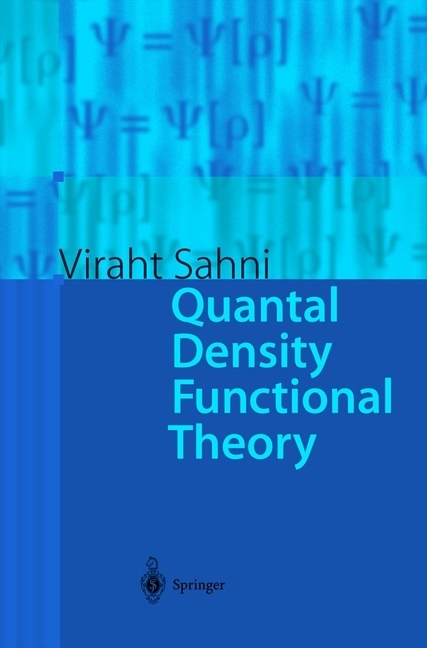En savoir plus
Quantal density functional theory (Q-DFT) is a new local effective potential energy theory of the electronic structure of matter. It is a description in terms of classical fields that pervade all space, and their quantal sources. The fields, which are explicitly defined, are separately representative of the many-body electron correlations present in such a description, namely, those due to the Pauli exclusion principle, Coulomb repulsion, correlation-kinetic, and correlation-current-density effects. The book further describes Schrödinger theory from the new perspective of fields and quantal sources. It also explains the physics underlying the functionals and functional derivatives of traditional DFT.
Table des matières
1. Introduction.- 2. Schrödinger Theory from the Perspective of 'Classical' Fields Derived from Quantal Sources.- 3. Quantal Density Functional Theory.- 4. The Hohenberg-Kohn Theorems and Kohn-Sham Density Functional Theory.- 5. Physical Interpretation of Kohn-Sham Density Functional Theory.- 6. Quantal Density Functional Theory of the Density Amplitude.- 7. Quantal Density Functional Theory of the Discontinuity in the Electron-Interaction Potential Energy.- 8. Further Insights Derived Via Quantal Density Functional Theory.- 9. Epilogue.- Appendices.- A. Proof of the Pure State Differential Virial Theorem.- B. Proof of the Harmonic Potential Theorem.- C. Analytical Expressions for the Properties of the Ground and First Excited Singlet States of the Hooke's Atom.- D. Derivation of the Kinetic-Energy-Density Tensor for Hooke's Atom in Its Ground State.- E. Proof of the S System Differential Virial Theorem.- F. Derivation of the Pair-Correlation Density in the Local Density Approximation for Exchange.- References.
Résumé
Quantal density functional theory (Q-DFT) is a new local effective potential energy theory of the electronic structure of matter. It is a description in terms of classical fields that pervade all space, and their quantal sources. The fields, which are explicitly defined, are separately representative of the many-body electron correlations present in such a description, namely, those due to the Pauli exclusion principle, Coulomb repulsion, correlation-kinetic, and correlation-current-density effects. The book further describes Schrödinger theory from the new perspective of fields and quantal sources. It also explains the physics underlying the functionals and functional derivatives of traditional DFT.
Texte suppl.
"Gives physical insight because it renders the many-fermion problem in as close to a classical mechanical and electrodynamical form as can be imagined... It is an interesting, unconventional, and useful contribution to the DFT literature. "
-- INT. J. QUANTUM CHEM.
"This book shows how in an entirely new way, it becomes plausible to use the wave function within the broad context of DFT, thus redirecting the present computational approach of attempting to approximate the presently unknown, and thus largely mysterious, HK energy functional of the density. The claim is that the simplicity of the equations of DFT is retained on the one hand, while on the other hand, ridding them of their mystery, as contained in the Kohn-Sham (KS) local potential … The book describes all quantum systems, including atoms and molecules, in terms of the fields inherent to the systems deriving from their quantal sources. Indeed, an innovation of QDFT is to identify all such fields, and to explicitly write their dependence upon the various quantal sources. The result is a description of quantum chemistry that is as close to a classical description as one may imagine….
"All readers interested in how DFT fits within the larger theoretical structure of quantum theory will profit from this book. It marshals an effective argument for the existence of a specifically Q-DFT view of the density as cardinal object of quantum theory. To accept that argument in its entirety is to see Q-DFT as the fulfillment of the HK theorem promise, to turn the density into all the quantum properties of a chemical system. That in turn could lead to a conceptual and computational revolution within quantum chemistry, the like of which has not been seen since the original HK and KS papers of some 40 years ago." – J. CHEM. EDUCATION (L. Massa, CUNY)
Commentaire
"Gives physical insight because it renders the many-fermion problem in as close to a classical mechanical and electrodynamical form as can be imagined... It is an interesting, unconventional, and useful contribution to the DFT literature. "
-- INT. J. QUANTUM CHEM.
"This book shows how in an entirely new way, it becomes plausible to use the wave function within the broad context of DFT, thus redirecting the present computational approach of attempting to approximate the presently unknown, and thus largely mysterious, HK energy functional of the density. The claim is that the simplicity of the equations of DFT is retained on the one hand, while on the other hand, ridding them of their mystery, as contained in the Kohn-Sham (KS) local potential ... The book describes all quantum systems, including atoms and molecules, in terms of the fields inherent to the systems deriving from their quantal sources. Indeed, an innovation of QDFT is to identify all such fields, and to explicitly write their dependence upon the various quantal sources. The result is a description of quantum chemistry that is as close to a classical description as one may imagine....
"All readers interested in how DFT fits within the larger theoretical structure of quantum theory will profit from this book. It marshals an effective argument for the existence of a specifically Q-DFT view of the density as cardinal object of quantum theory. To accept that argument in its entirety is to see Q-DFT as the fulfillment of the HK theorem promise, to turn the density into all the quantum properties of a chemical system. That in turn could lead to a conceptual and computational revolution within quantum chemistry, the like of which has not been seen since the original HK and KS papers of some 40 years ago." - J. CHEM. EDUCATION (L. Massa, CUNY)

